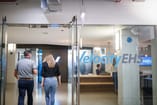
I would know that rat anywhere. The curve of his spine, the delicate perfection of his rib cage, legs bent in classic rodent crouch and that built-for-mischief rodent skull. The rat, or, more specifically, his white plastic skeletal facsimile, is a star, a celebrity whose photo has been splashed all over geek publications, including Wired magazine.
So when Tom Burtonwood, master printer at Chicago's brand spankin' new 3D Printer Experience (3DPX)—a hybrid store, workshop and studio/classroom—handed me the plastic skeleton, almost literally hot off the press, it was like meeting an old friend. The magic, of course, is that Ratus plasticus (not its official name...), who was a mere 10 months old when he made his history-making voyage through a medical CT scanner, is very likely still alive, white fur and adorable whiskers intact.
Almost 120 years after the accidental discovery of the X-ray gave us a way to peer inside bodies sans scalpel, it is now possible to recreate exactly what's inside—and to make copies wherever and whenever we'd like. Ratus plasticus is immortal, an instant artifact slicing through time, space and imagination.
"We are like archaeologists," notes Burtonwood, "but unearthing objects from the future." Or recent past. Or, since virtually anything can be scanned, ancient history. Burtonwood, who also teaches at the School fo the Art Institute of Chicago, began to experiment with 3D printing by scanning pieces from the museum's collection, turning them into plastic tchotchkes. Not even the iconic lions were safe...

The playfulness of the objects masks the serious potential of the technology. The lion's screw and socket system, for example, was designed on a computer and printed so precisely to spec that the head twists on perfectly straight.
Likewise, the popular "head scans" offered at 3DPX, are a kind of "gateway" amusement. It is fun—and funny—to stand on a platform in the window, spinning in place for a scan. But when you see a file of you in neon green being twirled and tweaked on a computer screen, your every gesture mimicked to perfection, the ramifications of what just happened begin to sink in. Mini-me is a kind of clone.
At least on the surface. The literal strength of additive manufacturing—as 3D printing is also called—is on the inside. "Topology optimization," to use the fancy term, is about finding the perfect balance of strength and lightness, often biomimicking nature.
"...The results of topology optimization are structures that have outward dimensions identical to normal load-bearing elements such as beams, yet have interior dimensions that look very different from traditionally manufactured parts. In place of triangular or circular voids, these parts have remarkably organic, almost bone-like shapes. The reason is, topology optimization software systematically analyzes the stresses on these shapes and then removes the most superfluous material from the design. This process is repeated over and over by the optimization software, and by the end the computer design leaves only a skeletal interior structure..."
—Brian H. Jaffe, Topology Optimization in Additive Manufacturing: 3D Printing Conference
Additive manufacturing is a whole new way of thinking about how things can be created, whether it's rat skeletons, fashions, or buildings. And just as there are "digital natives"—children who never knew a world without smart phones, touch screens and tablets—there will be "3D natives," for whom the miracle of printing objects will simply be a regular part of everyday life.
Indeed, a new middle school tech academy set to open in Charlottesville, Virginia, will have one 3D printer for every four students. Charlottesville is a pioneer, but as the costs of printers, scanners, computer software and feedstocks keep dropping— in no small measure due an onslaught of virally popular crowdfunded projects on Kickstarter and Indiegogo—more schools will follow.
Almost every day—and from seemingly every part of the globe—someone is coming up with a nifty new way to play with 3D printing. For example, Doodle3D from the Netherlands, provides a child-friendly way to turn drawings into objects, no computer programming experience required. Tellingly, though, as the company's Kickstarter video shows, it also brings out the inner-inventor in adults as well.
[video:http://vimeo.com/64217276 align:center]
"I still think it's a little miracle," says Frans Beelen, who designed a colorful handle to more easily carry several shopping bags at once.
Yes, Frans, it really is.
– J. A. Ginsburg / @TrackerNews / originally published on TrackerNews Dot to Dot
RELATED:
- 3D Printing of Preclinical X-ray Computed Tomographic Data Sets / Journal of Visualized Experiments (JOVE) / video & scientific paper
- Shapeways, MakerBot, and Lux Capital Stoke Ambitions for 3-D Printing / João-Pierre S. Ruth / xconomy




